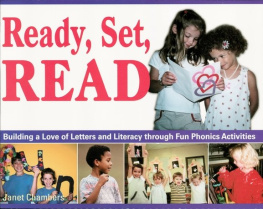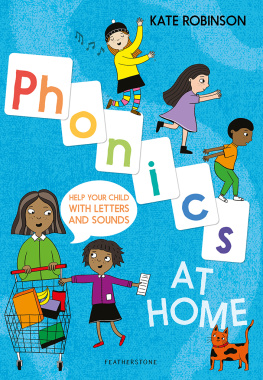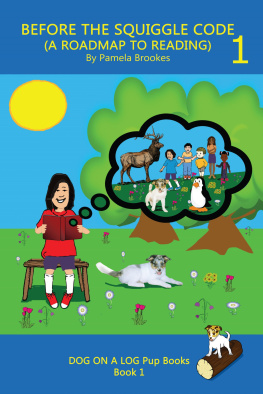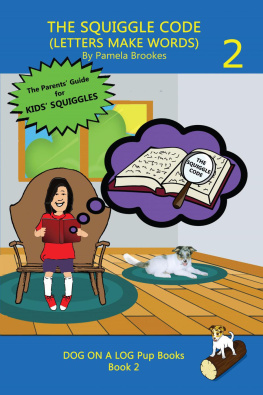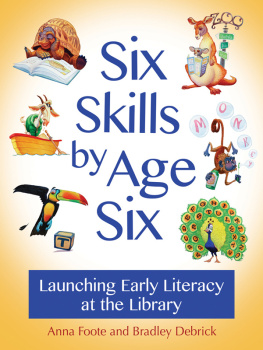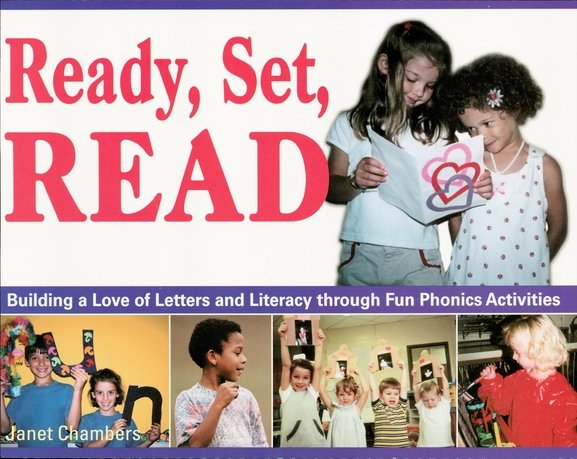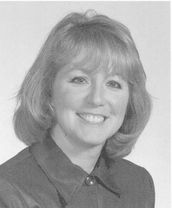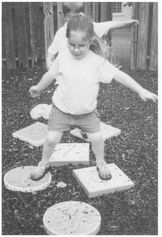F or the last 20 years, Janet Chambers has taught reading and writing to children of all ages first in the United Kingdom and more recently in Alabama.
One of Janets first jobs as a newly qualified teacher was working with at-risk adolescents who already had many years of negative literacy experiences behind them. Determined to turn this around, Janet devised innovative hands-on learning experiences to get the students
engaged in reading and writing. Her success with these students quickly convinced Janet of the value of teaching literacy through the senses. Using the same approach, Janet has developed a rich program for introducing the tools of literacy to young children before they learn that reading is hard, boring, or for other people. Currently using her multisensory technique in a preschool, Janet is delighted to report that most of her students enter kindergarten already able to read and write and bubbling with enthusiasm for their next adventures in learning.
Bibliography
Ahlberg, J., and A. Ahlberg. 1980. Funnybones. New York: Mulberry Books
Ahlberg, A., and A. Amstutz. 1990. The Pet Shop. Funnybones series. New York: Greenwillow Books.
Arnold, T. 1997. Huggly Gets Dressed. New York: Scholastic.
Asch, F. 1990. Skyire. New York: Scholastic.
Beck, A. 2001. Elliot Digs for Treasure. Tonawanda, N.Y.: Kids Can Press.
Benjamin, C. 1999. Footprints in the Sand. New York: Scholastic.
Brett, J. 1997. The Hat. New York: Scholastic.
Bridwell, N. 1985. Clifford: The Big Red Dog. New York: Scholastic.
. 1997. Cliords First Valentines Day. New York: Scholastic.
Brown, M. W 1991. Goodnight Moon. New York: HarperCollins.
Brumbeau, J., and G. de Marcken. 2000. The Quiltmakers Git. Duluth, Minn.: Pfeiffer-Hamilton.
Cannon, J. 1993. Stellaluna. New York: Scholastic.
Capucilli, A. S. 2000. Inside a Zoo in the City. New York: Scholastic.
Carle, E. 2001. Today Is Monday. New York: Philomel Books.
. 1994. The Very Hungry Caterpillar. New York: Philomel Books.
. 1999. The Very Lonely Firefly. New York: Philomel Books.
. 1990. The Very Quiet Cricket. New York: Scholastic.
Child, D. 1993. Psychology and the Teacher. London; New York: Cassell.
Chugani, H. T. 1991. Imaging Human Brain Development with Positron Emission Tomography. Journal o Nuclear Medicine 32, 1:2326.
Craig, J. 1998. Little Groundhogs Shadow. Mahwah, N. J.: Troll.
Csikszentmihalyi, M. 1990. Flow: The Psychology of Optimal Experience. New York: Harper & Row.
Dussling, J. 1995. In a Dark, Dark House. New York: Scholastic.
Edwards, R. 1999. Copy Me, Copycat. New York: Scholastic.
Ehlert, L. 1999. Red Leaf, Yellow Leaf. New York: Scholastic.
Fleming, D. 1999. Mama Cat Has Three Kittens. New York: Scholastic.
. 1997. Time to Sleep. New York: Scholastic.
Graham-Barber, L. 1998. Say Boo! New York: Scholastic.
Gruber, S. 1985. The Monster Under My Bed. Mahwah, N.J.: Troll.
Hall, Z. 1999. Its Pumpkin Time! New York: Scholastic.
Henkes, K. 2001. Wemberly Worried. New York: Scholastic.
Hoberman, M. A. 2000. Eensy Weensy Spider. New York: Scholastic.
Hubbard, P. 1996. My Crayons Talk. New York: Scholastic.
Jensen, E. 1998. Teaching with the Brain in Mind. Alexandria, Va.: ASCD.
Jeram, A. 2000. Bunny, My Honey. New York: Scholastic.
Kennedy, K. 2002. Pirate Pete. New York: Harry N. Abrams.
Kotulak, R. 1996. Inside the Brain. Kansas City, Mo.: Andrews and McMeel.
McBratney, S. 1996. Guess How Much I Love You. Cambridge, Mass.: Candlewick Press.
McGeorge, C. W 1997. Boomers Big Day. New York: Scholastic.
. 1996. Boomer Goes to School. New York: Scholastic.
Marzollo, J. 1997. I Am an Apple. New York: Scholastic.
Morris, A. 1989. Bread, Bread, Bread. New York: Mulberry Books.
Murphy, J. 1997. A Piece of Cake. Cambridge, Mass.: Candlewick Press.
. 1993. A Quiet Night In. Cambridge, Mass: Candlewick Press.
Nicoll, H., and J. Piehkowski. 1975. Mogs Lunch Box. London: Puffin.
Numeroff, L. J. 1992. If You Give a Moose a Muin. New York: Scholastic.
. 1999. If You Give a Pig a Pancake. New York: Scholastic.
Parker, V 1996. Bearobics. New York: Scholastic.
Penn, A. 1998. The Kissing Hand. New York: Scholastic.
Pinkwater, D. M. 1993. The Big Orange Splot. New York: Scholastic.
Piper, W 1998. The Little Engine That Could. New York: Dutton.
Rauscher, F. H., G. L. Shaw, L. J. Levine, K. N. Ky, and E. L. Wright. 1993. Music and Spatial Task Performance. Nature 365:611.
Rockwell, A. 2002. valentines Day. New York: Scholastic.
Schwartz, B. A. 2000. What Makes a Rainbow? Santa Monica, Calif.: Intervisual Books.
Sendak, M. 1992. Where the Wild Things Are. New York: Harper Festival.
Senisi, E. B. 2001. Fall Changes. New York: Scholastic.
Siomades, L. 2000. Three Little Kittens. New York: Scholastic.
Spier, P. 1989. Oh, Were They Ever Happy. New York: Doubleday.
Stoddard, S. 1997. Turtle Time. New York: Houghton Mifflin.
Ward, C. 1988. Cookies Week. New York: Scholastic.
Weeks, S. 1998. Mrs. McNosh Hangs Up Her Wash. New York: Scholastic.
Wells, R. 1997. Maxs Dragon Shirt. New York: Scholastic.
Williams, N. 1969. Child Development. London: Heinemann.
Child Development, Brain Research, and Multisensory Learning
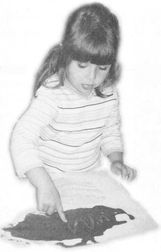
Why Use a Multisensory Approach?
If friends show you photographs they took on their vacation, you show polite interest. If they show you photographs of a place you have actually been to, you probably will have genuine interest. Reference points aid our recall of something we understand. If we look through our own photographs, they conjure up a moment, a feeling, an experience. Each photograph can bring to mind people, places, sounds, sights, smells, tastes, emotions, and other memories. The photograph is a trigger, a starting point, to retrieve a real experience.
Teachers are faced with many opportunities and challenging responsibilities. Our primary job is to provide education in the form of meaningful experiences. If our teaching does not mean something to our students, we are wasting both our time and theirs. We cannot rely on books and flat images to provide the kinds of hands-on experiences that will spur our students growth.
Experts in brain theory believe that emotional experiences stimulate the brain, and this in turn helps us to retrieve stored information efficiently. If the emotional experiences are positive, learning will be a happy experience (Jensen 1998). We all know that if we feel good about something, well want to do it again. Our young children are natural scientists; they thrive on pleasurable hands-on discoveries. A well-prepared multisensory approach in the classroom can provide such positive, stimulating learning experiences.

